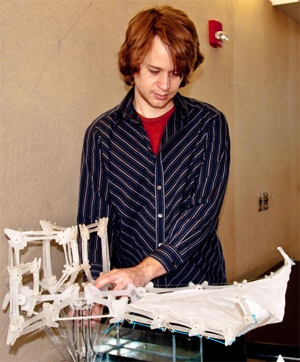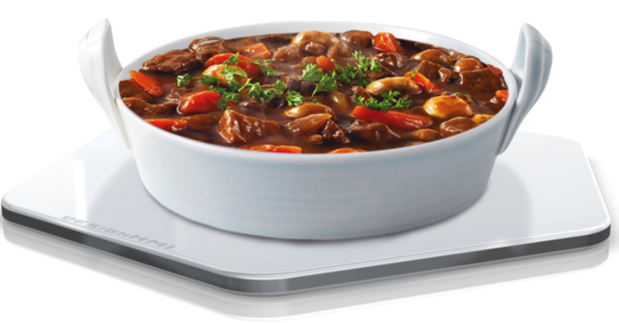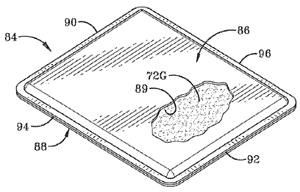 The Phase Change Matters e-mail newsletter is a weekly summary of the latest news and research on phase change materials and thermal energy storage. To subscribe, visit www.puretemp.com/subscribe. For more frequent updates, follow @puretemp on Twitter or visit the Phase Change Matters blog, www.puretemp.com/pcmatters.
The Phase Change Matters e-mail newsletter is a weekly summary of the latest news and research on phase change materials and thermal energy storage. To subscribe, visit www.puretemp.com/subscribe. For more frequent updates, follow @puretemp on Twitter or visit the Phase Change Matters blog, www.puretemp.com/pcmatters.
AWARDS
PCM-powered actuator is finalist for $50,000 Hackaday Prize
A thermal actuator that uses the power of phase change material to displace fluids and perform work is a finalist in the 2018 Hackaday Prize competition.
 The actuator, designed by Andrew Benson of Denver, Colo., is competing in the power harvesting category. The challenge: Build a module that harvests ambient power and show the module powering a project. Benson’s actuator retracts and expands as the PCM freezes or melts. The concept is described on the competition’s website, hackaday.com.
The actuator, designed by Andrew Benson of Denver, Colo., is competing in the power harvesting category. The challenge: Build a module that harvests ambient power and show the module powering a project. Benson’s actuator retracts and expands as the PCM freezes or melts. The concept is described on the competition’s website, hackaday.com.
“Thermal actuators are generally inefficient, but extraordinarily reliable,” Benson wrote in his contest entry. “This inefficiency can be overlooked when the thermal actuator is powered by waste or ambient heat. They are often used as thermal feedback mechanisms, such as the wax thermostat found in many water cooled engines. Environmental control systems can be created where a thermal actuator reacts to the environment, such as a shade device that deploys when ambient temperature rises above the melting temperature of the PCM.”
The five Hackaday Prize winners will be announced at the Hackaday Superconference in early November. The grand prize: $50,000.
CROWDFUNDING
Creators of PCM-equipped warming trivet abandon project
The team behind TheM, a PCM-powered warming trivet touted on Indiegogo a few years back, has finally scrapped the idea.
The team fell far short of its goal of raising $30,000 on the crowdfunding site in 2015. Technical challenges, combined with unspecified “medical problems,” proved to be too much.
 In the team’s first Indiegogo update since April 2016, team member Bobby Bedi recently wrote:
In the team’s first Indiegogo update since April 2016, team member Bobby Bedi recently wrote:
“Have been trying to validate the Thermal Dining Place Mat using PCM as heat sponge. Application concept for the PCM (Phase Change Material) was to initially store excess heat from the oven hot dish, and then to transfer heat when dish starts cooling to maintain food at an enjoyable temperature of 35 C for 30 minutes+.
“Unfortunately despite trying different Phase Change Materials the concept failed. Heat transfer from very hot dish to PCM was negative. The only other way was to add a heater which would have defeated the original concept. Project was also negatively funded and after investing another $10K from my end need to close this and find another solution to this want of keeping food hot without external heating wires.”
Bedi said he would try to issue refunds to any of the project’s 48 backers who would like their money back.
PATENTS
Encapsulates
U.S. patent application 20180215983 (applicant Encapsys LLC, Appleton, Wis.):
“The invention discloses a microencapsulated phase change material having a specific Thermal Efficiency Index (TEI). The composition of the invention comprises particles of a microencapsulated phase change material, the particles comprising a core and a shell that encapsulates the core, the shell comprising a polyurea obtained by polymerizing an isocyanate and an amine, prepared by (i) providing a water phase with an emulsifier, (ii) providing an internal phase of a core material and a multifunctional isocyanate soluble or dispersible in the internal phase, (iii) adding the internal phase to the water phase under high speed agitation to form an emulsion comprising droplets of the internal phase dispersed in the water phase and forming a first shell at an interface of the internal phase droplets and water phase mixture, and (iv) adding a multifunctional amine monomer to the emulsion thereby forming additional polyurea shell over the first shell at an interface of the internal phase droplets and water phase mixture. The resulting particles have a Thermal Efficiency Index greater than 0. Microcapsules according to the invention are highly effective at delivering enhanced thermal performance as compared to conventional microcapsules.”
Shape-stabilized phase change material for heat retention applications
U.S. patent application 20180215981 (applicant EGC Enterprises Inc., Chardon, Ohio):
“A thermal storage device includes a fabric base and a phase-change material provided on the base for storing and releasing heat applied to the thermal storage device.”
Insulated chamber with PCM and door with controllable transparency
 U.S. patent application 20180216833 (applicant Caron Products and Services Inc., Marietta, Ga.):
U.S. patent application 20180216833 (applicant Caron Products and Services Inc., Marietta, Ga.):
“A hinged door for gaining access to a chamber interior region for receiving a storage item therein. The hinged door comprising a frame, a transparent material pane within the frame, a smart glass material disposed proximate the material pane and controllable between a transparent and opaque condition responsive to an electric current supplied to the smart glass material, a phase change material [72G] within the frame, and a temperature controlling device proximate the phase change material.”
Device for controlling temperature of low-temperature pump
U.S. patent application 20180216610 (applicant Korea Aerospace Research Institute, Daejeon, South Korea):
“A cryopump comprising: a displacer configured to adjust an outside temperature by compressing or expanding a refrigerant included in the cryopump; a thermal conductor configured to transfer an external heat of the cryopump to the refrigerant; and a thermal conductive buffer configured to absorb the external heat transferred to the refrigerant and use the absorbed external heat as a phase change energy when the displacer is turned off.”
Method and system for phase change material component cooling
U.S. patent application 20180216894 (applicant General Electric Co., Schenectady, N.Y.)
“A transient cooling system includes a first phase change material (PCM) element and a second PCM element. The first PCM element includes a first PCM, a first surface, and a second surface, the first surface complementary to a surface to be cooled. The second PCM element includes a second PCM and a third surface in thermal contact with the second surface. The first PCM and the second PCM may have different thermal characteristics.”
Fuel cell freeze protection device and system
U.S. patent application 20180219237 (applicant Ford Motor Co., Dearborn, Mich.)
“A fuel cell system including a fuel cell stack, a coolant loop and a thermal battery. The coolant loop is configured to flow a coolant liquid therethrough. The thermal battery includes a phase change material configured to absorb heat generated by the fuel cell stack or coolant liquid and to latently store the heat during a first mode of operation the fuel cell system.”
Related:
• Vehicle occupant cooling system (applicant Toyota Motor Engineering & Manufacturing North America Inc., Erlanger, Kentucky)
IN BRIEF
• A bipartisan bill promoting innovation in sustainable chemistry was reintroduced in the U.S. Senate this week. The bill is sponsored by Susan Collins, R-Maine, and Chris Coons, D-Del. Collins said the legislation “would create a coordinated national effort to support research and development in the sustainable chemistry field; provide grants, training, and educational opportunities for scientists and engineers; and support American jobs by maintaining our nation’s scientific leadership.”
• PCM maker va-Q-tec AG is expanding its international presence with a new Latin American head office and operations facility in Montevideo, Uruguay. The new site will function as a hub for va-Q-tec’s pharma shipper rental service.
• Sener and Acciona Industrial have begun the salt melting process at the 100MW Kathu concentrated solar power plant in South Africa’s Northern Cape Province. The molten salt will be used to store heat from the solar field for up to 4.5 hours. The heat can be recovered later to produce steam and generate electricity.
• In response to a U.S. threat to raise a proposed tariff rate on $200 billion worth of Chinese goods to 25 percent, China has threatened to impose tariffs on $60 billion in U.S. goods.
• The U.S. Army is seeking proposals for a “cooling radio vest” that uses phase change material to keep the wearer at a comfortable 72 degrees F. The vest must include two radio pockets, a cell phone pocket, two utility pockets and space for a hydration panel. The list of requirements also specifies: “Cooling elements are a non-gel. Non ice mil spec aluminum packet consisting of a phase change material measuring 4.5″ x 2.6″ x 0.3.” The deadline for proposals is Aug. 13. One other detail: Just 22 units are needed.
RESEARCH ROUNDUP
For our full list of recent academic research, see puretemp.com/academic. Here are highlights from the past week:
From Applied Thermal Engineering:• Modelling and experimental study of latent heat thermal energy storage with encapsulated PCMs for solar thermal applications
From Journal of Energy Storage:
• Estimation of thermal performance and design optimization of finned multitube latent heat thermal energy storage
From Engineering Science and Technology:
• Experimental study on heat transfer performance of neopentyl glycol/CuO composite solid-solid PCM in TES based heat sink
From Solar Energy:
• Synthesis and characterization of stearic acid/silicon dioxide nanoencapsules for solar energy storage
• Experimental investigations of Alum/expanded graphite composite phase change material for thermal energy storage and its compatibility with metals
From International Journal of Thermal Sciences:
• Numerical study on the effect of phase change materials on heat transfer in asphalt concrete
From The Open Construction & Building Technology Journal:
• Thermal Performance of Resource-Efficient Geopolymeric Mortars Containing Phase Change Materials
From Chemical Engineering Journal:
• Flexible Phase Change Materials for Thermal Storage and Temperature Control
From Journal of Materials Chemistry A:
• Nanoconfinement of phase change materials within carbon aerogels: phase transition behaviours and photo-to-thermal energy storage
From Materiales de Construcción:
• Identification of best available thermal energy storage compounds for low-to-moderate temperature storage applications in buildings
NETWORKING
Connect with PCM experts and industry leaders on LinkedIn
 More than 1,300 people have joined a LinkedIn group devoted to the discussion of phase change material and thermal energy storage. The Phase Change Matters group is an interactive complement to the award-winning blog and newsletter of the same name.
More than 1,300 people have joined a LinkedIn group devoted to the discussion of phase change material and thermal energy storage. The Phase Change Matters group is an interactive complement to the award-winning blog and newsletter of the same name.
You are invited to join the group and connect with PCM and TES experts from around the world. This week we welcome Lisa Boussaba, a student at the University of Blida, Algeria; Rakib Hossain, thermal researcher at Christie Digital Systems, Ontario, Canada; Sankalp Arpit, research scholar at Indian Institute of Technology, Kharagpur, Ind